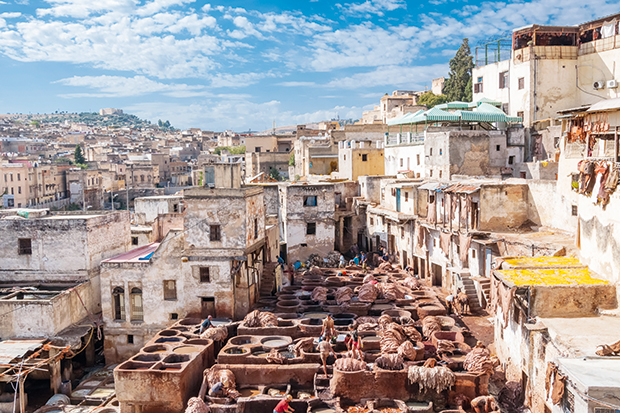Fez is one of the seven medieval wonders of the world. An intact Islamic city defined by its circuit of battlemented walls, it is riven by alleyways. You pass doorways that look into a 10th-century mosque, then a workshop courtyard, before coming through a teeming covered market and twisting past the high walls of a reclusive garden palace. The aesthetic highlight of any visit will be the teaching colleges built in the 14th century by the Merenid Sultans, and nothing can quite prepare you for the colours and odours of the open-air tanneries or the drama of listening to the dusk call to prayer from the ruins of the Merenid tombs.
To the north of the city rise the slopes of Jebel Zalagh, dotted with olive orchards. These warn of the Rif mountains beyond, a tough region that continues all the way to the Mediterranean shore. To the south, further from the walls, is the immense plateau of the Middle Atlas, where forests of cedar and holm oak are interspersed with nomadic grazing grounds. Standing between these two historic lodestones of Moroccan identity, Fez has always functioned as the fortress city that guarded the eastern approaches of Morocco — the Taza gap. But its chief claim to fame within North Africa is as the ancient intellectual centre of Morocco: the Arabic-speaking university town which for 1,300 years pumped the literate culture of Islam into the Berber body of the nation.
For the visitor, Fez offers up extremes by the hour, be it the beggar in supplication beside the chilled calm of a palatial riad hotel or the mad cacophony of hammer blows from the metalworkers’ market next to the cloistered calm of the mosque. The alleyways can be packed not just with crocodiles of tourists but with veiled Moroccan ladies shopping for their Friday lunch, mules laden with pungent skins on a fast trot downhill, and streams of exuberant kids pouring out of school. I know of an eminent historian who advises a walk through Fez as the best way to understand the reality of ancient Rome.
Most tourists come as part of a cultural coach tour and pack in too much, too quickly. But there is another way. Once a year Fez opens its doors to the Sacred Music Festival, which for the past 20 years has colonised the city during the last week of May. Open-air theatres and concert halls are constructed by framing a 13th-century gateway or building platforms in 19th-century walled gardens. And like a returning vision of the city’s intellectual golden age, scholars, musicians, poets and mystics are invited back to grace this city of ancient culture.
If, incidentally, you are wondering about the Seven Wonders of the Medieval World, don’t bother consulting the web, which will unaccountably list such prehistoric wonders as Stonehenge and classical wonders as the Colosseum. Byzantine Hagia Sophia, the Great Wall of China, Mameluke Cairo, Lalibella in Ethiopia, Fez of the Merenids, Angkor Wat and Florence must be pretty sure of a place. The seventh is more contentious, but Ely, Cologne, Cordoba, Winchester, Notre Dame, Durham, Chartres and Damascus must surely be among the leading -candidates.
Got something to add? Join the discussion and comment below.
Get 10 issues for just $10
Subscribe to The Spectator Australia today for the next 10 magazine issues, plus full online access, for just $10.
You might disagree with half of it, but you’ll enjoy reading all of it. Try your first month for free, then just $2 a week for the remainder of your first year.














Comments
Don't miss out
Join the conversation with other Spectator Australia readers. Subscribe to leave a comment.
SUBSCRIBEAlready a subscriber? Log in